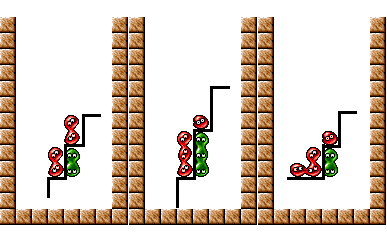Stairs (階段積み) is a chaining form that allows the falling Puyo to connect horizontally. Because of its visual structure, this is often the first form a Puyo player learns.
Here are some examples of Stairs chains:
Stairs gets its name because in this form, each Puyo group rests on a different "step" of the Stairs.

Source: Puyo Nexus
A typical Stairs Chain is made of two parts:
There are three forms of Stairs:
3-1 Stairs
2-2 Stairs
1-3 Stairs
The transition is a group of Puyos that are stacked vertically and connects your top and bottom chains together. A typical Stairs transition is built at the wall of the board and is usually paired up with 1-3 Stairs.
There are many ways to make a transition, but there are two common forms:
A short transition uses the fewest Puyos possible to raise your chain so that you can continue to extend it. It is the simplest and most basic type of transition.
A Sandwich transition is the transition that most Puyo players use, as it is more effective at taking up vertical space. It gets its name because the transition uses a Sandwich form.
Short Transition
Sandwich Transition
This is the most important thing to remember when building Stairs.
Many other guides on Stairs state to start building it at the end of the chain.
However, I have seen many players do this, and they all face the same problem: they don't know what to do with pieces that don't fit in the chain.
(Then they max out at a 5 chain, and lose to a 6.)
The solution here is build the transition first, because there are more options to place pieces compared to late-transiton Stairs.
Here are the best placements to start the transition:
AA AB
▼
AA BB
▼
AA BC
▼
AB BC
▼
So now you have your base transition. Now it's time to build off of that transiton.
Specifically, you should expand upwards and outwards.
Let me explain...
When you are building Stairs, the most important thing to do is to complete your transition. And you need to do that as fast as possible.
So, if your Puyo pairs can build the transition, then place it there (expand upwards). If not, then place the pair to build the Stairs instead (expand outwards).
For example, lets say you have this as the start of your transition:
The next piece is a green-yellow pair. Since it does not make sense to put it in the transition, we can use it to build the Stairs.
After that, we get a red-blue pair. Because we can use that pair to complete the transition, let's place it in the first two columns.
Now, we have a blue-yellow pair. We can use it to extend the transition, or to extend the Stairs. Since the transition is more important, lets place the piece there.
We can continue this cycle for each pair that we get.
...and so on.
I think you get the point.
Here is a common problem:
You are trying to build up the transition, but you can't get the pieces to finish it.
Enter: Puyo Propping
Instead of praying that the right single-colored piece will come, try building a transition with a different single-colored piece.
This single-colored piece gets propped up by the lone Puyo underneath it (the blue Puyo).
Sure, it's not the cleanest transition...
...but it gets the job done.
And when you are pressured for time, that's all that matters.
In a perfect world, the end of your Stairs would look like this:
Unfortunately, we don't live in a perfect world.
Which is why you might want to sandwich the end of your chain, especially when you're running out of room:
Stairs Pattern: Intermediate Level : This guide for building the Stairs Form was the inspiration for writing this guide. It's written in French, but it is readable thanks to Google Translate. Note that this guide calls Stairs "Classic".
Transitions 1: The Second Floor: An more in depth look into the concept of the Stairs transition.